Catocala of Prince Edward Island
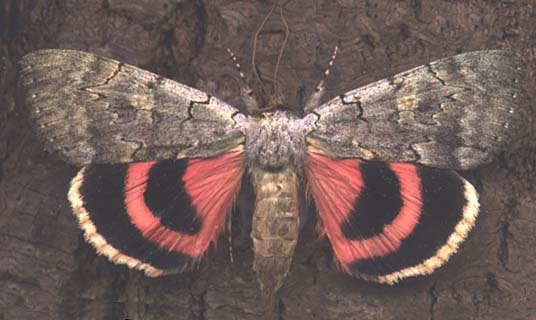
Catocala concumbens,
posed scan on poplar bark by Bill Oehlke,
Montague, Prince Edward Island, August 22, 2002

The following table divides all North American Catocala species into twenty one different groups. Moths are grouped according to hindwing colour bands (yellow, orange, salmon, red, pink, black or white) and wingspan measurements (small = 35-55mm, medium = 55-75 mm and large = 75mm plus).
There is some overlap regarding size. Generally if a species exceeds the upper limits of one group, I have placed it in the group with the larger span. There is also subjective interpretation of colour. What is orange to me, may be yellow or salmon to another, etc..
Wingspan refers to the distance from wing tip to wing tip when the moths are spread with the inner margin of the forewing perpendicular to the body.
Those found on Prince Edward Island are located in their respective groupings.
Although there is a historical record for Catocala amatrix, I have not seen that species on PEI.
YELLOW
|
ORANGE
|
SALMON
|
RED
|
PINK
|
BLACK |
WHITE
|
Return to Canadian Index
Return to Main Index
Little Yellow-Orange Underwings: Wingspans: 35-45mm
Little Yellow-Orange Underwings: Wingspans: 35-56mm |
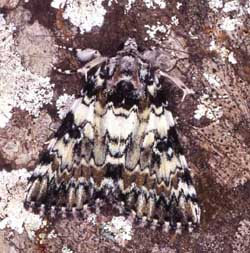
| ** 8877 connubialis, Connubial Underwing, (wingspan: 35-50mm). FW is highly variable and there are several different forms: "sancta" Hulst is typical form and has forewings with white ground colour and sharply contrasting black lines and markings. There is also brown shading between pm and subterminal lines; "cordelia" H. Edwards is coloured as above but markings are faint; "pulverulenta" Brower has grey-green forewings with faint markings, sometimes none; "broweri" Muller is melanic form with fws that are dark green, almost black. Hw has separate anal spot and outer band ends with straight cut. |
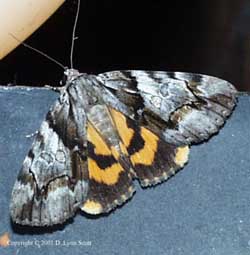
| ** 8867 Catocala blandula;
Charming Underwing, wingspan: 40-50mm. |
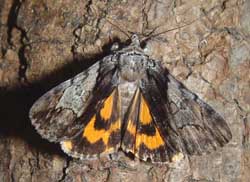
| ** 8858 Catocala crataegi WO; Hawthorn Underwing, wingspan: 40-50mm: Determination is based on dark (black) shading in forewing basal area continuing along inner margin to anal angle and brown shading beyond postmedial line. There is also a definite greenish cast to median area. Hw has outer black band, broken near the anal angle, distinguishing crataegi from blandula. Tim Dyson image. |
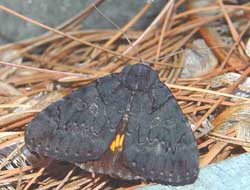
| ** 8775 antinympha; Sweetfern Underwing, wingspan 45-55mm.: The very dark grey, almost black, forewing ground colour distinguishes antinympha. There is some brown shading in the subreniform spot and also just outside the postmedial line. The hindwing is amber to pale orange. There is also the form multoconspicua Reiff, 1919 with a pale, almost white subreniform spot. Tim Dyson image. |
** 8775 antinympha form multiconspicua; Sweetfern Underwing, wingspan 45-55mm.: There is also the form multiconspicua Reiff, 1919 with a pale, almost white subreniform spot. Multiconspicua also has a much more contrasting forewing than the "normal" antinympha. The very dark, and extensive dark grey to black hindwing fringe is diagnostic in all forms. Steve Lemieux image. |
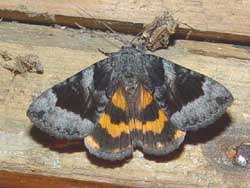
| ** 8776 badia coelebs; Old Maid Underwing, wingspan 54-56mm.: The gray region from the forewing pm line to the outer margin readily distinguishes this species. The fringe is gray on the lower wing from the brief orange dash at the hindwing apex to the anal angle.Tim Dyson image. maybe |
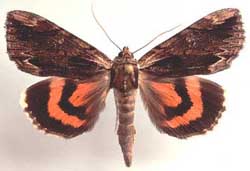
| ** 8857 Catocala ultronia; Ultronia Underwing, wingspan: 50-63mm.Fws typically gray-brown, with a distinct and very dark inner margin and characteristic light brown patch, underscored by very dark arc, near wingtip. Underwings can be yellow to orange to salmon. |
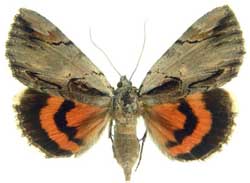
| ** 8857 Catocala ultronia form lucinda; Ultronia Underwing, wingspan: 50-63mm.In form lucinda most of the forewing is bright grey. On all forms there is
extensive orange-salmon colouration on hw ventral surface,
and there is a dark discal lunule. |
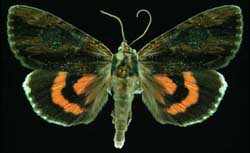
| Catocala ultronia, form nigrescens, the Ultronia Underwing, wingspan: 50-63mm. In the melanic form nigrescens, the dorsal forewing is very dark. Even darker subapical arc, basal dash and dash near anal angle are still visible. Dark basal hairs on hindwing. Harold J. Vermes slide, used with permission from his son. |
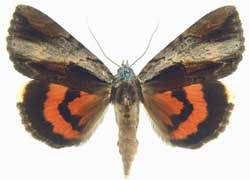
| Catocala ultronia form celia.
In form celia there is a wide, light grey band separating a dark region along inner margin and
a dark patch near the apex.
The ventral surface of forewings of all forms has a generous suffusion
of orange-salmon scales in the lower half of the median area. |
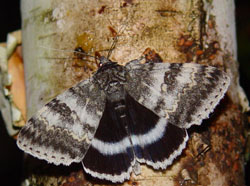
| ** 8803 Catocala relicta
;
Forsaken, White, Relict; 70-80mm:
Considerable variation with regard to black/white
concentrations on fws. |
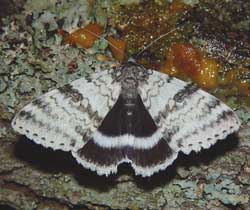
| ** 8803 Catocala relicta ; Forsaken, White, Relict; 70-80mm: Considerable variation with regard to black/white concentrations on fws. Form clara: basal and subterminal areas predominantly white.Typical specimens have basal and subterminal areas with blackish scales. Black hws, with brilliant even white inner band and white fringe, are distinctive. June until October. |
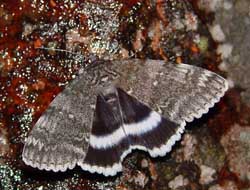
| ** 8803 Catocala relicta ; Forsaken, White, Relict; 70-80mm: Considerable variation with regard to black/white concentrations on fws. Form phrynia: evenly dusted with grey over entire forewing. Typical specimens have basal and subterminal areas with blackish scales. Black hws, with brilliant even white inner band and white fringe, are distinctive. June until October, poplars and willows |
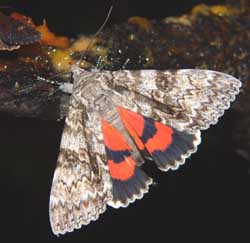
| ** 8821 semirelicta; Semirelict Underwing; wingspan: 65-75mm. Fw ground colour white with dark lines and shadings. Diffuse dark bar runs from center of basal area to outer margin a few mm above anal angle. Note regular dentation of st line. Inner black bar on lower wing usually terminates well before inner margin. The form "atala" has forewing that is uniformly grey. Unijuga is usually larger and has less contrasting black lines. Inner black bar on unijuga usually reaches inner margin. Tim Dyson image. historical records only |
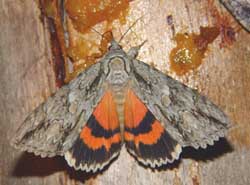
| ** 8806 Catocala parta ?; Mother Underwing, wingspan: 70-85mm. The black dashes in the basal, subapical and anal areas help to identify this species. The hindwings may be yellow to yellowish-orange but more often are salmon-red. Note the face-head-like markings on the thorax. In the hindwing, the first (nearest the apex) black protrusion into the white fringe is "noticeably" larger than the others. |
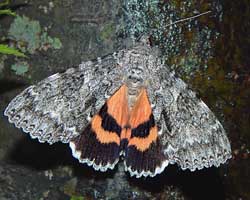
| ** 8805 unijuga; Once-married; wingspan: 70-90mm. Unijuga has fairly wide black inner band (almost reaching inner margin) in hindwing and very distinctive patterning in forewing. Meskei tend to have narrower band and dustier (less distinct) looking forewing. Semirelicta tend to have inner bands terminating well before i. m. Note very white fringe on fwgs and hwgs. Carroll Rudy image. |
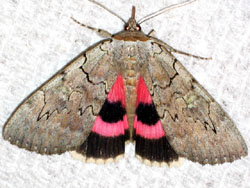
| ** 8833 concumbens Sleepy Underwing or Pink Underwing (wingspan: 60-75mm).
Brown thoracic collar quite evident in this image as is
interruption in pm line by open subreniform spot.
|
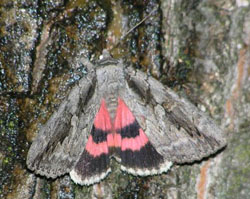
|
** 8834 amatrix Sweetheart Underwing; (wingspan 75-95mm). Very skittish, frequently hides in caves, under bridges, under tree bark, etc. by day, resting with head down. Hw patterning and colouration similar to that of C. concumbens, but large size (wingspan 75-95mm) and dark bar running from basal area to just below apex distinguishes C. amatrix. See large Catocala amatrix courtesy of Joan F. Rickert. |
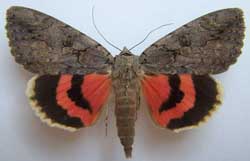
|
** 8834 amatrix form selecta
Sweetheart Underwing; (wingspan 75-95mm) |
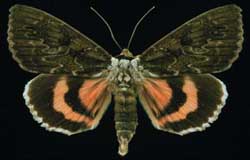
|
** 8834 amatrix form hesseli
Sweetheart Underwing; (wingspan 75-95mm) |
This page is brought to you by Bill Oehlke and the WLSS. Pages are on space rented from Bizland. If you would like to become a "Patron of the Sphingidae and/or Catocala Sites", contact Bill.
Please send sightings/images to Bill. I will do my best to respond to requests for identification help.
Enjoy one of nature's wonderments: Live Saturniidae (Giant Silkmoth) cocoons.